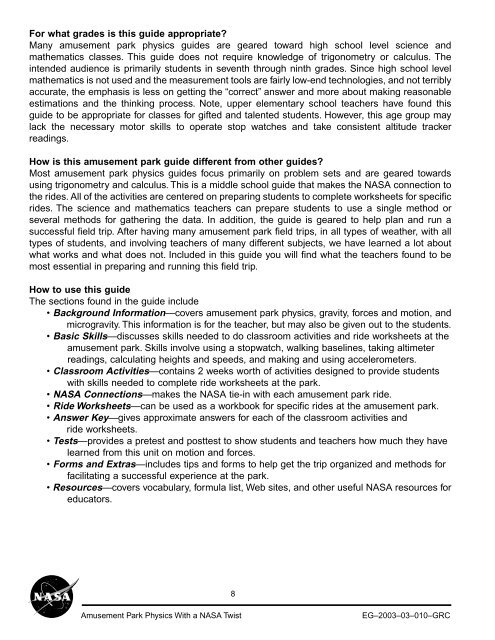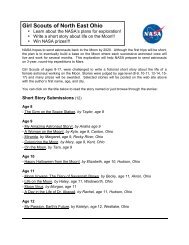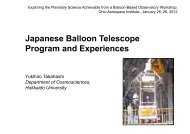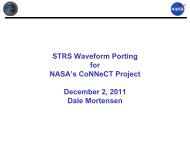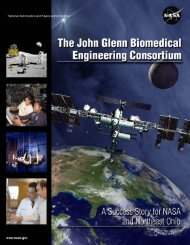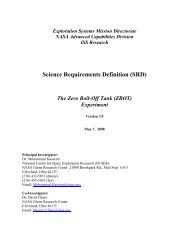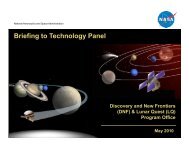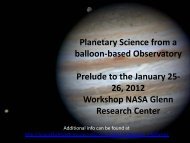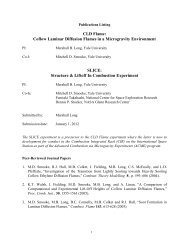Amusement Park Physics With a NASA Twist - Space Flight Systems ...
Amusement Park Physics With a NASA Twist - Space Flight Systems ...
Amusement Park Physics With a NASA Twist - Space Flight Systems ...
Create successful ePaper yourself
Turn your PDF publications into a flip-book with our unique Google optimized e-Paper software.
For what grades is this guide appropriate<br />
Many amusement park physics guides are geared toward high school level science and<br />
mathematics classes. This guide does not require knowledge of trigonometry or calculus. The<br />
intended audience is primarily students in seventh through ninth grades. Since high school level<br />
mathematics is not used and the measurement tools are fairly low-end technologies, and not terribly<br />
accurate, the emphasis is less on getting the “correct” answer and more about making reasonable<br />
estimations and the thinking process. Note, upper elementary school teachers have found this<br />
guide to be appropriate for classes for gifted and talented students. However, this age group may<br />
lack the necessary motor skills to operate stop watches and take consistent altitude tracker<br />
readings.<br />
How is this amusement park guide different from other guides<br />
Most amusement park physics guides focus primarily on problem sets and are geared towards<br />
using trigonometry and calculus. This is a middle school guide that makes the <strong>NASA</strong> connection to<br />
the rides. All of the activities are centered on preparing students to complete worksheets for specific<br />
rides. The science and mathematics teachers can prepare students to use a single method or<br />
several methods for gathering the data. In addition, the guide is geared to help plan and run a<br />
successful field trip. After having many amusement park field trips, in all types of weather, with all<br />
types of students, and involving teachers of many different subjects, we have learned a lot about<br />
what works and what does not. Included in this guide you will find what the teachers found to be<br />
most essential in preparing and running this field trip.<br />
How to use this guide<br />
The sections found in the guide include<br />
• Background Information—covers amusement park physics, gravity, forces and motion, and<br />
microgravity. This information is for the teacher, but may also be given out to the students.<br />
• Basic Skills—discusses skills needed to do classroom activities and ride worksheets at the<br />
amusement park. Skills involve using a stopwatch, walking baselines, taking altimeter<br />
readings, calculating heights and speeds, and making and using accelerometers.<br />
• Classroom Activities—contains 2 weeks worth of activities designed to provide students<br />
with skills needed to complete ride worksheets at the park.<br />
• <strong>NASA</strong> Connections—makes the <strong>NASA</strong> tie-in with each amusement park ride.<br />
• Ride Worksheets—can be used as a workbook for specific rides at the amusement park.<br />
• Answer Key—gives approximate answers for each of the classroom activities and<br />
ride worksheets.<br />
• Tests—provides a pretest and posttest to show students and teachers how much they have<br />
learned from this unit on motion and forces.<br />
• Forms and Extras—includes tips and forms to help get the trip organized and methods for<br />
facilitating a successful experience at the park.<br />
• Resources—covers vocabulary, formula list, Web sites, and other useful <strong>NASA</strong> resources for<br />
educators.<br />
8<br />
<strong>Amusement</strong> <strong>Park</strong> <strong>Physics</strong> <strong>With</strong> a <strong>NASA</strong> <strong>Twist</strong><br />
EG–2003–03–010–GRC


